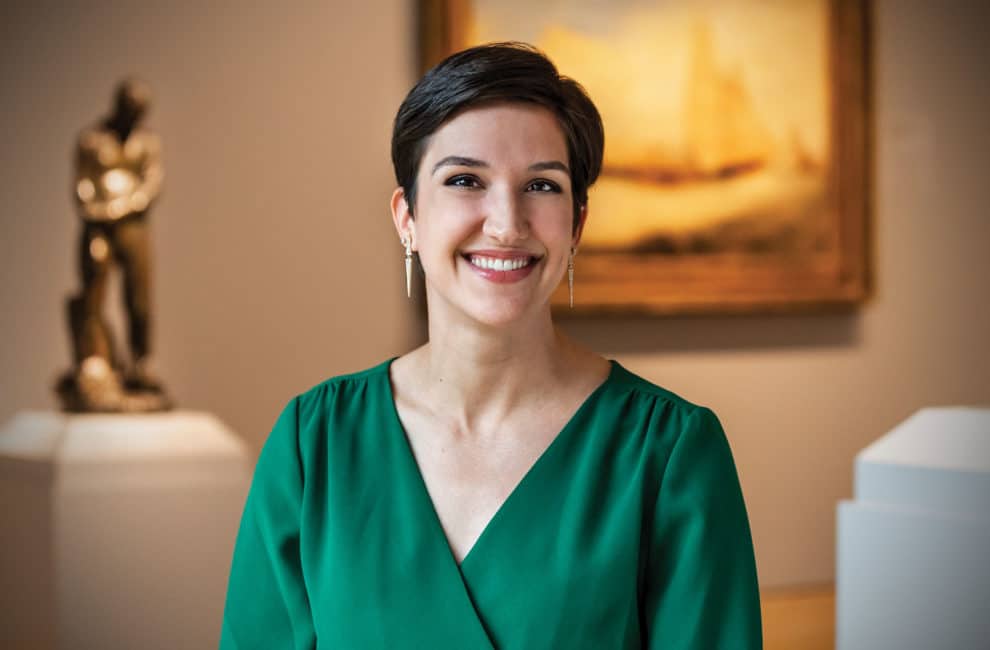Ask Me Anything: Anna Stein, Museum Curator

Anna Stein, the assistant curator of works on paper at Newfields. Courtesy Newfields
Newfields owns the iconic Edward Hopper painting Hotel Lobby. How crucial was that to the Virginia Museum of Fine Arts curators?
It was critical. When they came to us proposing an exhibition—even before I knew I was going to be the venue curator for it—I was excited to show it off.
When you lend to another museum, do you get any say in how it will be shown?
Usually, we’re not divas about it.
How far ahead are these major exhibitions planned?
Years. Once we knew we were doing it with them, we got our team together. Even for a show that we’re getting from somewhere else, there’s a lot of planning that goes into making it work in our space. We set our own interpretation goals.
So will the show be different here than it was in Virginia?
Quite. Our show is going to have fewer individual groupings of paintings, but larger ones. They had smaller galleries. I think we’re going to go a little different with the graphic design and the color palette. Things like that make it our own.
How is the show organized?
It’s broken down thematically. There are other artists in the show that deal with hotel subjects. A little more than half of it is Hopper paintings, drawings, and magazine covers.
He worked for trade magazines, correct?
He spent a huge percentage of his career doing that. He knew all about the hotel industry. So there’s a section about that. There’s a section on motels, which were a relatively new phenomenon. They started popping up in the 1930s, but after the war, there was a big boom. Hopper was a bit of a curmudgeon. You can read his wife, Josephine’s, diaries, and they would go on these road trips when he would grump about every motel room.
She’s an important piece of the story?
She was everything. He did not have a successful fine-art exhibition until she got him into one. His career didn’t take off until they were married. Everything we know about their trips, we know about from her diaries and the postcards she sent back to his art dealer. He was quiet. She was very outspoken and chatty. Imagine them in a car together for weeks. They drove each other nuts. I loved getting into their personal dynamics.
Did she drive?
He wouldn’t let her.
I’m guessing she was more likely to talk with his subjects.
She was. She would get their stories and put little snippets in the diaries. And the model for the women in his paintings was always Jo.
Did he just say, “Go over there, look downtrodden, and put a hat on”?
She would pose back in the studio for him. He might change the hair and the outfit, but you’ll see some similarities.
Did he also take liberties with places?
The general rule with Hopper is that his interiors are made up and his exteriors tend to be actual places. Hotel Lobby and some of the other famous interiors aren’t real places, but he’s basing them on the hundreds of hotels he saw.

Hotel Lobby by Edward HopperPAINTING BY Edward Hopper (American, 1882–1967), Hotel Lobby, 1943, oil on canvas, 32-1/4 × 40-3/4 in. Indianapolis Museum of Art at Newfields, William Ray Adams Memorial Collection, 47.4 (C) Edward Hopper.
In the middle of the Newfields temporary shows, there’s usually some kind of interactive component. What do you have planned for this?
We’re going to do a postcard-writing activity. We’ll have reproductions of vintage Indiana postcards and prompts to write about a travel memory. You can have it displayed or take it home with you. And we’ll have some of Josephine Hopper’s travel journals and postcards on display. In the same space, we’re doing a slideshow designed to look like an old travel slideshow that your parents would have pulled out. We’re crowdsourcing travel photos. So if you have any, you should send some in.
And that’s something here but not in Virginia?
Right. Also, you’re going to be able to pick up a vintage phone and hear a short personal travel story—all true stories.
For instance?
People living in hotels, which was common. It was normal for someone to have a home where they rented out rooms. Some of that has come full circle with Airbnb. We’ll also look at women travelling alone and African-American travel at the time. That would have been a very different experience from Hopper’s.
Shades of Green Book.
Yes, the Green Book is the reference through which many people have learned about it. This was a time when rising middle-class African Americans wanted to hit the road in their car the same way that Hopper was hitting the road. But he and his wife could decide whether this hotel looked pretty good or if they should hit the next one. If you were an African-American family, there might be only one or two places in the city where you were welcome. We’re incorporating the story of a family that couldn’t find a place to spend a night in St. Petersburg.
How did Hotel Lobby, a major painting, become part of the Newfields collection?
It was given to us by a donor in 1947.
Where does it rank among the pieces requested by other institutions? In the top 10?
I’m not sure, but when I went and checked the history, I found a very thick file of loan requests for it.
But I’m guessing not quite in the Georgia O’Keeffe category.
It’s up there. Of course, we don’t approve every request.





